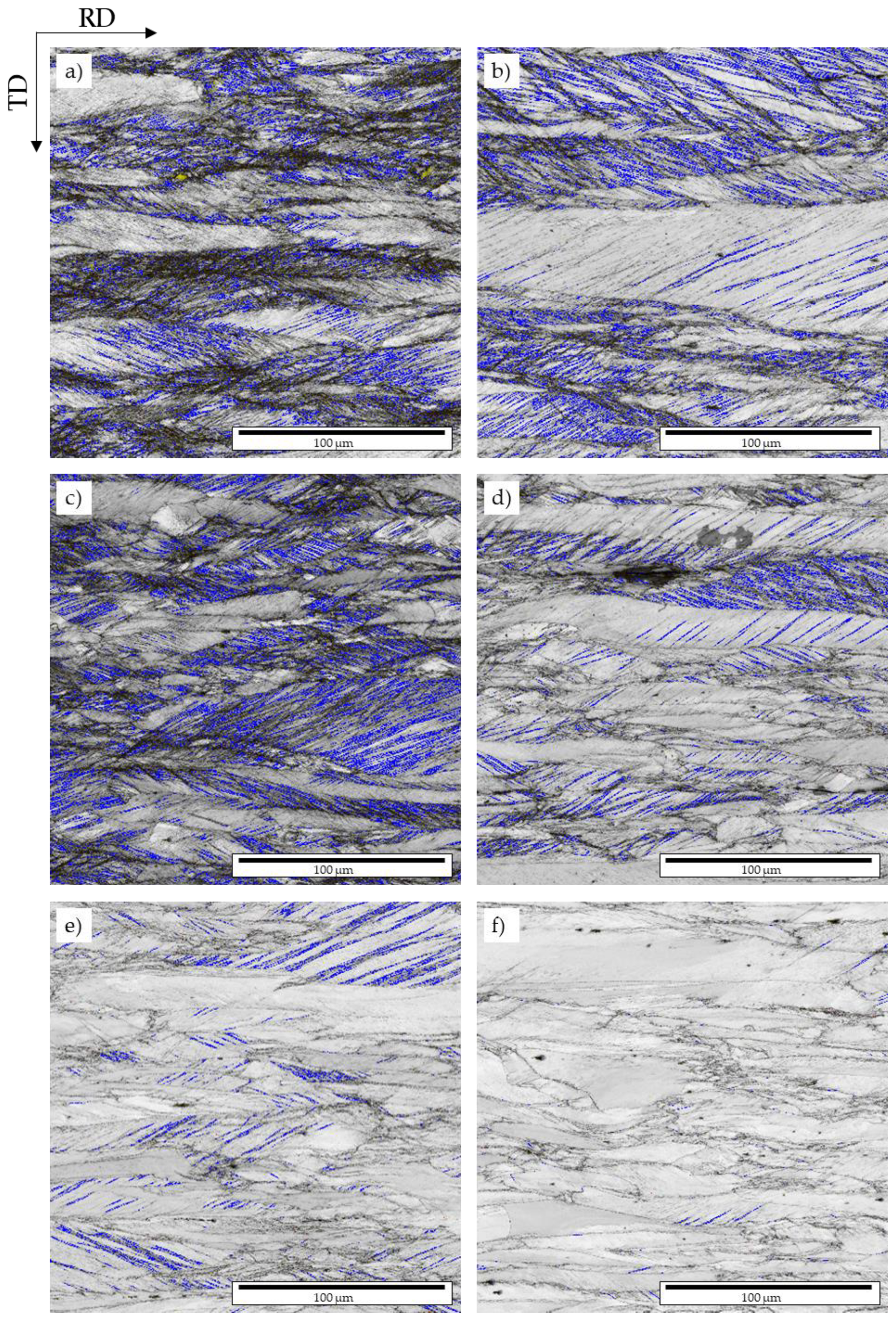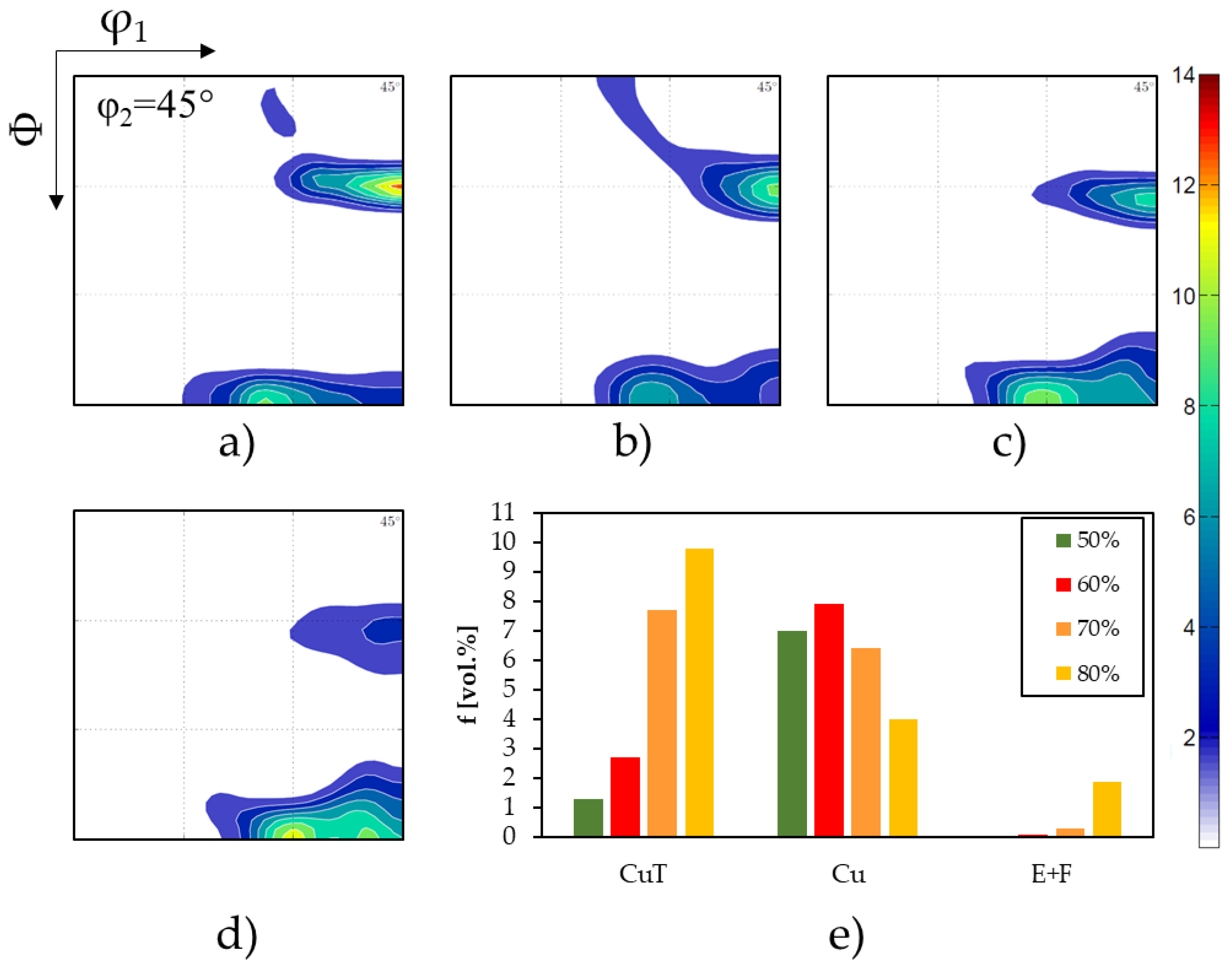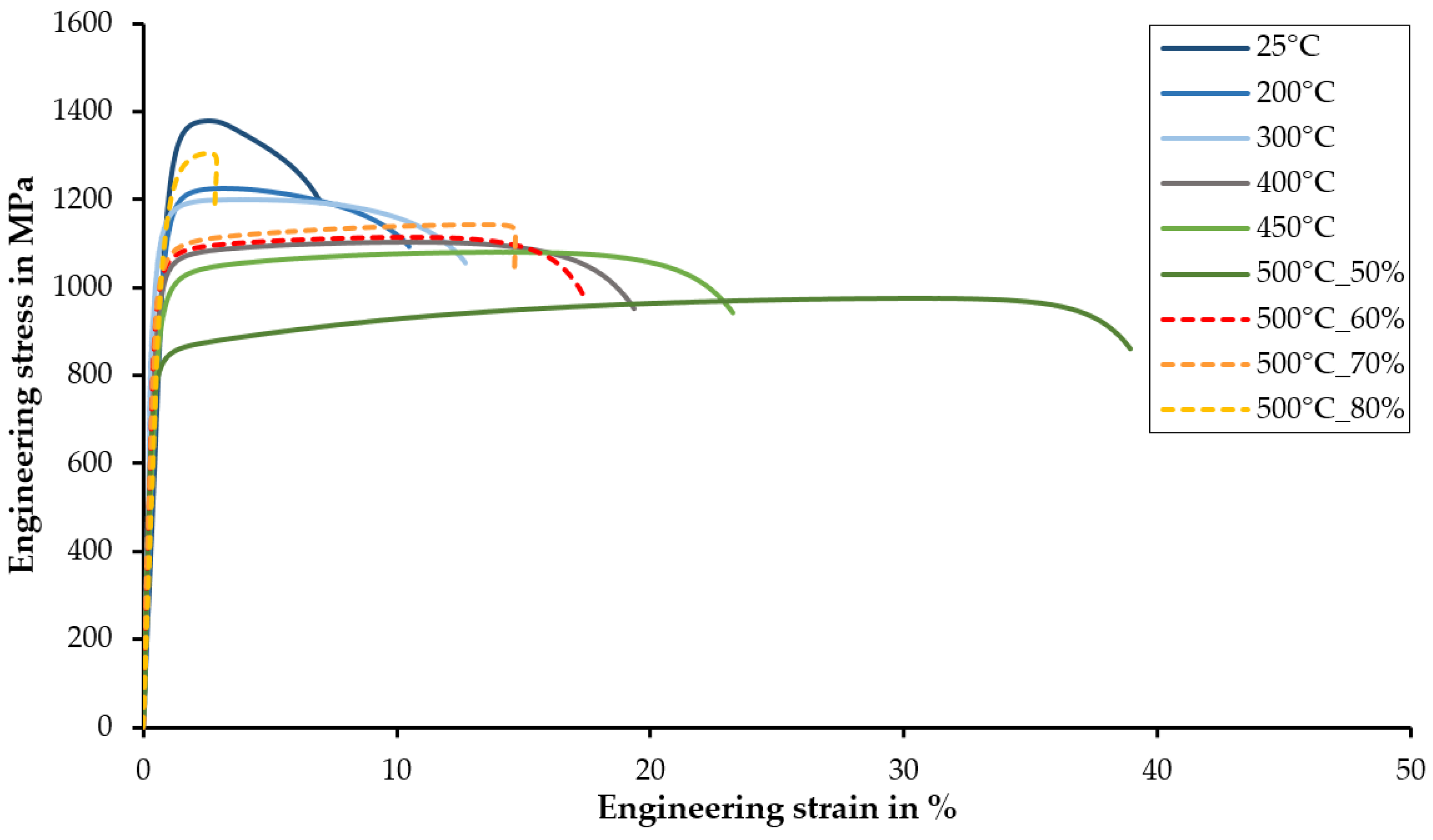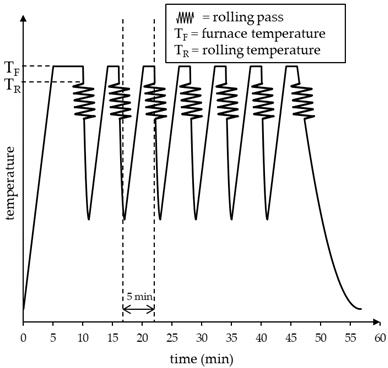The Influence of Warm Rolling on Microstructure and Deformation Behavior of High Manganese Steels
Abstract
1. Introduction
2. Materials and Methods
2.1. Material Processing
2.2. Sample Preparation and Characterization
3. Results
3.1. Microstructure
3.2. Influence of Rolling Temperature on Texture Evolution During Warm Rolling
3.3. Mechanical Properties
4. Discussion
5. Conclusions
- The temperature dependence of the stacking fault energy can be used to control the predominant deformation mechanism of high manganese steels during rolling. The performed EBSD measurements and XRD texture analysis show that the formation of deformation twins can be suppressed at 500 °C and thickness reduction of up to 50%.
- The specimens warm-rolled at temperatures higher than 300 °C exhibit exceptional mechanical properties due to the combination of slip and twinning. The adjustment of rolling temperature and rolling degree allows for tailoring the mechanical properties in a wide range. The resulting uniform and total elongation can be increased by increasing the rolling temperature, whereas yield and ultimate tensile strength decrease accordingly. The material benefits from strain hardening due to the slip effect at elevated temperatures. The twinning mechanism during deformation at room temperature, i.e., after prior warm rolling, accordingly enables a certain ductility and work hardening potential of the warm-rolled high manganese steel.
- The yield strength and overall strength level of a high manganese TWIP steel could be notably improved by warm rolling. A reasonable uniform and ultimate elongation could be maintained. Compared to a fully recrystallized Fe-23Mn-0.3C-1Al steel, the warm-rolled material states exhibit superior mechanical properties, especially in terms of strength.
Author Contributions
Funding
Conflicts of Interest
References
- Kusakin, P.; Belyakov, A.; Haase, C.; Kaibyshev, R.; Molodov, D.A. Microstructure evolution and strengthening mechanisms of Fe–23Mn–0.3C–1.5Al TWIP steel during cold rolling. Mater. Sci. Eng. A 2014, 617, 52–60. [Google Scholar] [CrossRef]
- Ueji, R.; Tsuchida, N.; Terada, D.; Tsuji, N.; Tanaka, Y.; Takemura, A.; Kunishige, K. Tensile properties and twinning behavior of high manganese austenitic steel with fine-grained structure. Scr. Mater. 2008, 59, 963–966. [Google Scholar] [CrossRef]
- Scott, C.; Remy, B.; Collet, J.L.; Cael, A.; Bao, C.; Danoix, F.; Malard, B.; Curfs, C. Precipitation strengthening in high manganese austenitic TWIP steels. Int. J. Mater. Res. 2011, 102, 538–549. [Google Scholar] [CrossRef]
- Bouaziz, O.; Barbier, D. Benefits of recovery and partial recrystallization of nano-twinned austenitic steels. Adv. Eng. Mater. 2013, 15, 976–9794. [Google Scholar] [CrossRef]
- Haase, C.; Kremer, O.; Hu, W.; Ingendahl, T.; Lapovok, R.; Molodov, D.A. Equal-channel angular pressing and annealing of a twinning-induced plasticity steel: Microstructure, texture, and mechanical properties. Acta Mater. 2016, 107, 239–253. [Google Scholar] [CrossRef]
- Berrenberg, F.; Haase, C.; Barrales-Mora, L.A.; Molodov, D.A. Enhancement of the strength-ductility combination of twinning-induced/transformation-induced plasticity steels by reversion annealing. Mater. Sci. Eng. A 2017, 681, 56–64. [Google Scholar] [CrossRef]
- Haase, C.; Barrales-Mora, L.A.; Molodov, D.A.; Gottstein, G. Tailoring the Mechanical Properties of a Twinning-Induced Plasticity Steel by Retention of Deformation Twins During Heat Treatment. Metall. Mater. Trans. A 2013, 44, 4445–4449. [Google Scholar] [CrossRef]
- Belyakov, A.; Kaibyshev, R.; Torganchuk, V. Microstructure and Mechanical Properties of 18%Mn TWIP/TRIP Steels Processed by Warm or Hot Rolling. Steel Res. Int. 2017, 88, 1600123. [Google Scholar] [CrossRef]
- Saeed-Akbari, A.; Imlau, J.; Prahl, U.; Bleck, W. Derivation and variation in composition-dependent stacking fault energy maps based on subregular solution model in high-manganese steels. Metall. Mater. Trans. A 2009, 40, 3076–3090. [Google Scholar] [CrossRef]
- Grajcar, A.; Kozłowska, A.; Topolska, S.; Morawiec, M. Effect of Deformation Temperature on Microstructure Evolution and Mechanical Properties of Low-Carbon High-Mn Steel. Adv. Mater. Sci. Eng. 2018, 2018, 1–7. [Google Scholar] [CrossRef]
- Zhang, J.; Di, H.; Mao, K.; Wang, X.; Han, Z.; Ma, T. Processing maps for hot deformation of a high-Mn TWIP steel: A comparative study of various criteria based on dynamic materials model. Mater. Sci. Eng. A 2013, 587, 110–122. [Google Scholar] [CrossRef]
- Barbieri, F.D.; Castro Cerda, F.; Pérez-Ipiña, J.; Artigas, A.; Monsalve, A. Temperature Dependence of the Microstructure and Mechanical Properties of a Twinning-Induced Plasticity Steel. Metals 2018, 8, 262. [Google Scholar] [CrossRef]
- Dolzhenko, P.; Tikhonova, M.; Kaibyshev, R.; Belyakov, A. Dynamically Recrystallized Microstructures, Textures, and Tensile Properties of a Hot Worked High-Mn Steel. Metals 2019, 9, 30. [Google Scholar] [CrossRef]
- Hirsch, J.; Lücke, K. Overview no. 76: Mechanism of deformation and development of rolling textures in polycrystalline f.c.c. metals—I. Description of rolling texture development in homogeneous CuZn alloys. Acta Metall. 1988, 36, 2863–2882. [Google Scholar] [CrossRef]
- Haase, C.; Barrales-Mora, L.A. Influence of deformation and annealing twinning on the microstructure and texture evolution of face-centered cubic high-entropy alloys. Acta Mater. 2018, 150, 88–103. [Google Scholar] [CrossRef]
- Saleh, A.A.; Haase, C.; Pereloma, E.V.; Molodov, D.A.; Gazder, A.A. On the evolution and modelling of brass-type texture in cold-rolled twinning-induced plasticity steel. Acta Mater. 2014, 70, 259–271. [Google Scholar] [CrossRef]
- Humphreys, F.J.; Hatherly, M. Recrystallization and Related Annealing Phenomena, 2nd ed.; Elsevier: Amsterdam, The Netherlands, 2004. [Google Scholar]
- Bracke, L.; Verbeken, K.; Kestens, L.; Penning, J. Microstructure and texture evolution during cold rolling and annealing of a high Mn TWIP steel. Acta Mater. 2009, 57, 1512–1524. [Google Scholar] [CrossRef]
- Haase, C.; Barrales-Mora, L.A.; Roters, F.; Molodov, D.A.; Gottstein, G. Applying the texture analysis for optimizing thermomechanical treatment of high manganese twinning-induced plasticity steel. Acta Mater. 2014, 80, 327–340. [Google Scholar] [CrossRef]
- Lü, Y.; Molodov, D.A.; Gottstein, G. Correlation Between Microstructure and Texture Development in a Cold-rolled TWIP Steel. ISIJ Int. 2011, 51, 812–817. [Google Scholar] [CrossRef]
- Vercammen, S.; Blanpain, B.; Cooman, B.C.D.; Wollants, P. Cold rolling behaviour of an austenitic Fe-30Mn–3Al–3Si TWIP-steel: The importance of deformation twinning. Acta Mater. 2004, 52, 2005–2012. [Google Scholar] [CrossRef]
- Haase, C.; Chowdhury, S.G.; Barrales-Mora, L.A.; Molodov, D.A.; Gottstein, G. On the Relation of Microstructure and Texture Evolution in an Austenitic Fe-28Mn-0.28C TWIP Steel During Cold Rolling. Metall. Mater. Trans. A 2013, 44, 911–922. [Google Scholar] [CrossRef]
- Hielscher, R.; Schaeben, H. A novel pole figure inversion method: Specification of the MTEX algorithm. J. Appl. Crystallogr. 2008, 41, 1024–1037. [Google Scholar] [CrossRef]
- Bachmann, F.; Hielscher, R.; Schaeben, H. Texture Analysis with MTEX—Free and Open Source Software Toolbox. SSP 2010, 160, 63–68. [Google Scholar] [CrossRef]
- Haase, C.; Ingendahl, T.; Güvenc, O.; Bambach, M.; Bleck, W.; Molodov, D.A.; Barrales-Mora, L.A. On the applicability of recovery-annealed twinning-induced plasticity steels: Potential and limitations. Mater. Sci. Eng. A 2016, 649, 74–846. [Google Scholar] [CrossRef]
- Haase, C.; Barrales-Mora, L.A.; Molodov, D.A.; Gottstein, G. Application of Texture Analysis for Optimizing Thermo-Mechanical Treatment of a High Mn TWIP Steel. AMR 2014, 922, 213–218. [Google Scholar] [CrossRef]
- Haase, C.; Zehnder, C.; Ingendahl, T.; Bikar, A.; Tang, F.; Hallstedt, B.; Hu, W.; Bleck, W.; Molodov, D.A. On the deformation behavior of κ-carbide-free and κ-carbide-containing high-Mn light-weight steel. Acta Mater. 2017, 122, 332–343. [Google Scholar] [CrossRef]






| Element | Fe | C | Si | Mn | P | S | Al | Ni | Mo | Cr |
|---|---|---|---|---|---|---|---|---|---|---|
| wt.% | Bal. | 0.322 | 0.053 | 22.45 | 0.008 | 0.008 | 0.995 | 0.027 | 0.008 | 0.020 |
| Temperature (°C) | Thickness Reduction (%) | Process Scheme | ||||
|---|---|---|---|---|---|---|
| TR | TF | 50 | 60 | 70 | 80 |  |
| 25 | - | x | ||||
| 200 | 220 | x | ||||
| 300 | 340 | x | ||||
| 400 | 460 | x | ||||
| 450 | 510 | x | ||||
| 500 | 570 | x | x | x | x | |
| Component | Symbol | Miller Indices | Euler Angles (φ1, Φ, φ2) | Fiber |
|---|---|---|---|---|
| Brass (B) |  | {110}<112> | (55, 90, 45) | α, β |
| Goss (G) |  | {110}<100> | (90, 90, 45) | α, τ |
| Cube (C) |  | {001}<100> | (45, 0, 45) | - |
| E |  | {111}<110> | (0/ 60, 55, 45) | γ |
| F |  | {111}<112> | (30/ 90, 55, 45) | γ |
| Copper (Cu) |  | {112}<111> | (90, 35, 45) | β, τ |
| Copper Twin (CuT) |  | {552}<115> | (90, 74, 45) | τ |
| α-fiber | <110> parallel to ND | |||
| β-fiber | <110> tilted 60° from ND towards RD | |||
| τ-fiber | <110> parallel TD | |||
| γ-fiber | <111> parallel ND | |||
| Rolling Temperature (°C) | Thickness Reduction (%) | Yield Strength (MPa) | Tensile Strength (MPa) | Uniform Elongation (%) | Total Elongation (%) |
|---|---|---|---|---|---|
| 25 | 50 | 1274 | 1379 | 1.6 | 6.1 |
| 200 | 50 | 1081 | 1227 | 2.8 | 9.8 |
| 300 | 50 | 1054 | 1200 | 3.3 | 12.3 |
| 400 | 50 | 959 | 1103 | 10.2 | 18.9 |
| 450 | 50 | 942 | 1082 | 13.6 | 22.6 |
| 500 | 50 | 788 | 975 | 30.1 | 38.5 |
| 500 | 60 | 999 | 1114 | 10.0 | 17.0 |
| 500 | 70 | 1015 | 1144 | 12.7 | 14.1 |
| 500 | 80 | 1133 | 1305 | 1.6 | 1.9 |
© 2019 by the authors. Licensee MDPI, Basel, Switzerland. This article is an open access article distributed under the terms and conditions of the Creative Commons Attribution (CC BY) license (http://creativecommons.org/licenses/by/4.0/).
Share and Cite
Haupt, M.; Müller, M.; Haase, C.; Sevsek, S.; Brasche, F.; Schwedt, A.; Hirt, G. The Influence of Warm Rolling on Microstructure and Deformation Behavior of High Manganese Steels. Metals 2019, 9, 797. https://doi.org/10.3390/met9070797
Haupt M, Müller M, Haase C, Sevsek S, Brasche F, Schwedt A, Hirt G. The Influence of Warm Rolling on Microstructure and Deformation Behavior of High Manganese Steels. Metals. 2019; 9(7):797. https://doi.org/10.3390/met9070797
Chicago/Turabian StyleHaupt, Marco, Max Müller, Christian Haase, Simon Sevsek, Frederike Brasche, Alexander Schwedt, and Gerhard Hirt. 2019. "The Influence of Warm Rolling on Microstructure and Deformation Behavior of High Manganese Steels" Metals 9, no. 7: 797. https://doi.org/10.3390/met9070797
APA StyleHaupt, M., Müller, M., Haase, C., Sevsek, S., Brasche, F., Schwedt, A., & Hirt, G. (2019). The Influence of Warm Rolling on Microstructure and Deformation Behavior of High Manganese Steels. Metals, 9(7), 797. https://doi.org/10.3390/met9070797






